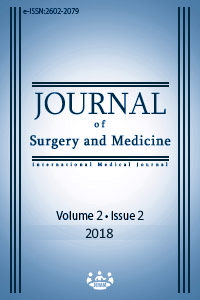Comparison of VAS scores recorded by nurse vs surgeon: A case-control study
Keywords:
Postoperative pain, VAS, Pain follow-upAbstract
Aim: VAS (Visual Analogue Scale) is a scale that is frequently used, easily understood and applied especially in the assessment of postoperative pain. Many parameters are performed mainly by the nurses in the follow-up of the patient in the post-operative period, and follow-up of the pain from the major complaints is also performed by the nurses. The purpose of the study is to exhibit whether the identity of the questioner, i.e., the nurse in charge or surgeon in charge, causes a change in the VAS scale in questioning VAS pain scoring.
Methods: 120 patients who underwent elective laparoscopic cholecystectomy were included the study and the postoperative pain scores of the patients were evaluated with VAS (Visual Analogue Scale) at 1st, 6th and 24th hours. The pain questioning was first performed by the nurse in charge and also 15 minutes later by the physician in charge. No analgesic administration was performed to the patients between the two questioners. The difference between the pain scores was assessed statistically whether it had changed with the identity of the questioners.
Results: It was detected that VAS 1, VAS 6 and VAS 24 score averages were significantly different according to physicians and nurses (p<0.05). VAS average of the nurse in the 1st hour was 2.39±1.42 and VAS average of the physician was 1.19±0.79, VAS average of the nurse in the 6th hour was 2.15±1.73 and VAS average of the physician was 1.35± 1.25, VAS average of the nurse in the 24th hour was 1.23±0.96 and VAS average of the physician was 0.68±0.75. For each VAS score; it was detected that VAS scores given by the nurses were significantly higher than the VAS score averages given by the physician (p<0.05).
Conclusion: We think that the identity of the questioner is also influential on the pain score expressed by the patient in the assessment of the postoperative pain made by using the VAS pain score, who questions the pain in the pain palliation made by using this scale should also be evaluated.
Downloads
References
Eti Aslan F. The assessment methods of pain. Journal of Cumhuriyet University School of Nursing. 2002;6:9–16.
Bergh I, Gunnarsson M, Allwood J, Odén A, Sjöström B, Steen B. Descriptions of pain in elderly patients following orthopaedic surgery. Scand J Caring Sci. 2005;19:110–18.
Watt-Watson J, Garfinkel P, Gallop R, Stevens B, Streiner D. The impact of nurses’ empathic responses on patients’ pain management in acute care. Nurs Res. 2000;49:191–20.
Karaçay P, Aslan FE, Selimen D. Acil travma ünitelerinde ağrı geçirme yaklaşımlarının belirlenmesi. Ağrı. 2006;8:44-51
Peacock MS, Patel MS. Cultural influences of Pain.Rev Pain. 2008;1:6-9
6.Katz J, Melzack R. Measurement of Pain. Surg Clin North Am. 1999;79:23152
Eti Aslan F. Akut ağrı kontrolünde hemşirenin rolü. Akut Ağrı (Özyalçın NS, Ankara). Güneş Kitapevi. 2005; pp 303-29
Kurşun YZ, Yıldız F, Kaymaz Ö, Önal SA. Ağrılı kanser hastalarının tedavisinde analjezik basamak tedavisinin yeri. Ağrı. 2015;27:26-34.
8.Bijur PE, Silwer W, Gallagher EJ. Reliability of the Visual Analog Scale for measurement of acute pain. Acad Emerg Med. 2001;81153-7.
Bergh I, Jakobsson E, Sjöström B. Worst experiences of pain and conceptions of worst pain imaginable among nursing students. J Adv Nurs. 2008;61:484–91.
Hawker GA, Mian S, Kendzerska T, French M. Measures of adult pain. Arthritis Care Res. 2011;63:240–52
Uzunoğlu S, Çiçin İ. Kanser hastalarında ağrıya yaklaşım. Klinik Gelişim Dergisi. 2011; 24:14-20.
Sloman R, Rosen G, Rom M, Shir Y. Nurse’s assessment of pain in surgical patients. Journal of Advanced Nursing. 2005;52:125-32.
Gordon DB, Dahl J, Phillips P, Frondsen J, Cowley C, Foster RL, et al. The use of 'as-needed' range orders for opioid analgesics in the management of acute pain: a consensus statement of the American Society for Pain Management Nursing and the American Pain Society. Home Healthcare Nurse. 2005;23:388-96.
Potter AP, Perry AG. Clinical Nursing Skills & Techniques, 6th. Edition, (2006) Elsevier Mosby USA
McCaffery M, Ferrell BR, Pasero C. Nurses’ personal opin- ions about patients’ pain and their effect on recorded as- sessments and titration of opioid doses. Pain Manag Nurs. 2000;1:79– 87.
Ene KW, Nordberg G, Bergh I, Johansson FG, Sjöström B. Postoperative pain management - the influence of surgical ward nurses. J Clin Nurs. 2008;17:2042–50.
Yıldırım M, Çizmeciyan ES, Kaya G, Başaran Z, Karaman FŞ, Dursun S. Perception of pain levels among orthopaedic surgery patients,their relatives and nurses. Agri. 2015;27:132-8
Alon E, Knessl P. Prevention and treatment of postoperative pain. Agri. 2000;12:9-14.
Sjostrom B, Dahlgren O.L, Haljamae H. Strategies used in postoperative pain assessment and their clinical accuracy. Journal of Clinical Nursing. 2000;9:111-8.
Puntillo K, Neighbor M, O’Neil N, Nixon R. Accuracy of emergency nurses in assessment of patients’ pain. Pain Manag Nurs. 2003;4:171–5
Duignan M, Dunn V. Congruence of pain assessment be- tween nurses and emergency department patients: a replication. Int Emerg Nurs. 2008;16:23-8.
Idvall E, Berg K, Unosson M, Brudin L. Differences between nurse and patient assessments on postoperative pain man- agement in two hospitals. J Eval Clin Pract. 2005;11:444–51.
Guru V, Dubinsky I. The patient vs. caregiver perception of acute pain in the emergency department. J Emerg Med. 2000;18:7–12.
Idvall E, Hamrin E, Sjöström B, Unosson M. Patient and nurse assessment of quality of care in postoperative pain management. Qual Saf Health Care. 2002;11:327–34.
Özer S, Akyürek B, Başbakkal B. Hemşirelerin ağrı ile ilgili bilgi, davranış ve klinik karar verme yeteneklerinin incelenmesi. Ağrı. 2006;18:36-43.
Martin KD, Van Buren JP, Wake J, Dawson L. Comparison of Vısual Analog Scale Pain Score Reported to Physician vs Nurse. Foot Ankle Int. 2018;39:300-3.
Downloads
- 3066 3153
Published
Issue
Section
How to Cite
License
Copyright (c) 2018 Oğuz Uğur Aydın, Eda Uysal Aydın
This work is licensed under a Creative Commons Attribution-NonCommercial-NoDerivatives 4.0 International License.
















